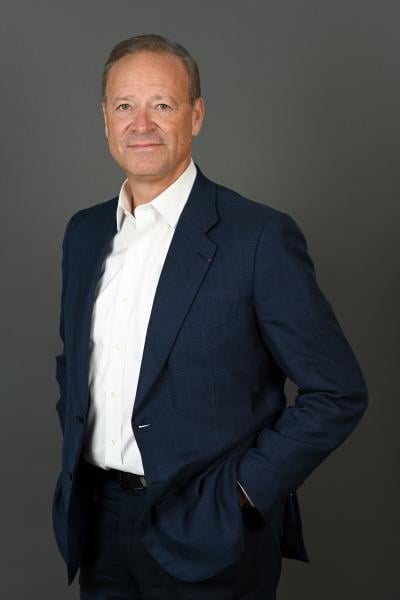Biogen’s new CEO Christopher Viehbacher has wasted no time getting a pipeline re-prioritization underway while signaling that the formerly restrained company is ready to make some deals.
“I tell people, well, there wasn't a lot of point hiring me if you don't want to go do deals,” Viehbacher said on Biogen’s fourth quarter earnings call Wednesday.
Viehbacher, who is returning to the top of the C-suite seven years after stepping down from the top position at Sanofi, took a page right out of the chief executive playbook by telling investors that he would be looking for “all of the above” in terms of business development. That could mean straight up acquisitions, licensing deals or other partnerships that bring some later-stage assets or early projects into the mix.
“The bankers like to refer to this desperation factor. I would argue that we don't have a high desperation factor. We actually have a lot that we can do within the company,” Viehbacher said. He noted that Biogen ended 2022 with about $5.6 billion in cash on hand and has more money coming from Samsung in the early second quarter, which means about $10 billion is available to "utilize."
"Firepower is not necessarily the main constraint, it's finding something that's worthwhile doing," he said.
It’s true that Biogen has a lot to do this year, including the launch of Alzheimer’s disease treatment Leqembi, which is waiting on a full approval from the FDA after receiving an accelerated nod in early January. Partner Eisai is leading the launch efforts on that med. The company is also awaiting an approval decision from the FDA on Sage Therapeutics-partnered zuranolone, which is under priority review for major depressive disorder and postpartum depression.

But Viehbacher and Executive Vice President and Head of Development Priya Singhal, M.D., detailed a relatively thin pipeline, with few near-term opportunities to follow in the footsteps of those few assets. Viehbacher seems to be taking a hard look at the pipeline and where Biogen has previously put its resources. While he’s on the lookout for business development, the CEO seemed to hint at some rehoming of internal assets as well.
“There have been a number of pet projects around and other areas where we're spending money,” he said. “One of the things I'm really trying to drive is focus in the company. What really matters? What's going to grow the business and how do we align our resources behind that? And whatever is not one of the major growth drivers, I think we have to look carefully at whether we continue to support that business with resources or we think about other options for some of those businesses.”
Viehbacher specifically signaled an increased interest in immunology and psychiatry—see zuranolone for the latter. But the CEO suggested that he wants to rethink how R&D is done at the company and how risky assets are managed. With the probability of success for a phase 1 asset at about 10%, Viehbacher said Biogen has historically leaned towards getting proof of efficacy in phase 3. He would like to better understand a drug’s promise earlier in the clinic.
“We are sometimes doing proof of concept in phase 3, which is an expensive way to do proof of concept,” he said. “So just even thinking about moving into some of these other areas allows us to do more classical drug development.”
Zeroing in on the pipeline a bit more, Singhal previewed multiple early-stage Alzheimer’s assets, meds for multiple sclerosis, amyotrophic lateral sclerosis and more. The first assets to hit the scrapheap on Viehbacher’s watch were announced during the fourth quarter earnings call (PDF): the MS therapy orelabrutinib and the diabetic painful neuropathy med vixotrigine. Viehbacher and his team hinted that more is to come this year.
“Our goal is to rebalance the R&D pipeline,” Singhal said. She detailed a focus on Alzheimer’s med BIIB080, which started a phase 2 study in the fourth quarter. The company is also working on two therapies for lupus, dapirolizumab pegol and litifilimab. The goal is to boost productivity in the pipeline and decrease risk.
“In R&D, we're looking at this whole prioritization exercise. And that means if you want to save money to a degree, you may have to cut some programs—and that's not something that you want to do quickly,” Viehbacher said. “You need to go and look at each program thoroughly, determine probabilities of success, cost to complete, a whole bunch of other things.”
That doesn’t mean Biogen is going to completely de-risk its pipeline and opt for all safe bets.
“Having a few of those projects in our pipeline is good. Having 100% of our pipeline and projects like that is challenging,” Viehbacher said. “To me, risk management is something that is part of the day job in a pharma company. You obviously can't do anything unless you take risks.”
He went on to warn investors that they may have to wait awhile to see some updated milestones from Biogen: “If you look at it, we don't really have an approval coming in our pipeline for several years yet here, because we're waiting on these long-term studies. So having things that read out on a little bit more frequent basis, would be helpful to looking at sustainable growth of the company.”
That means his pledge to restore M&A activity, too. While he is eager to get to the negotiating table, Viehbacher said these things take time, and he expects discussions to get underway in this year's second half. That would put any resulting deal announcements into next year.
“It takes a while to go find things. You’ve got to look at a lot of things before you do something,” the CEO said. “I think it's healthy to be looking outside and to always have options because in this business, nothing ever goes completely to plan.”